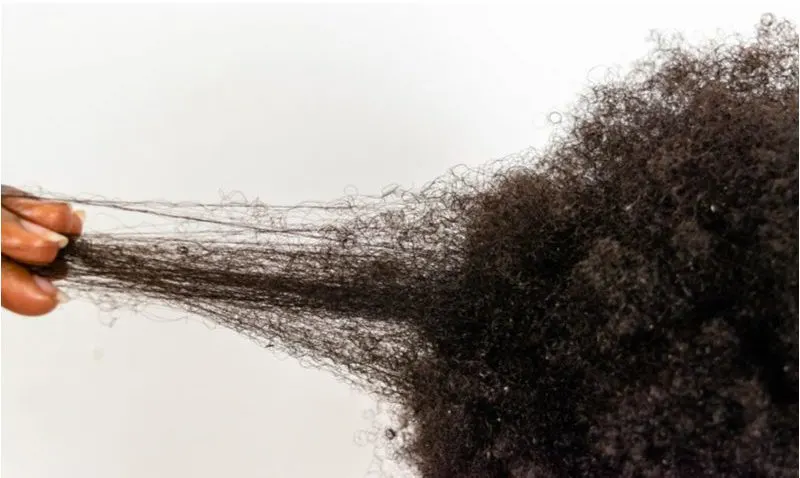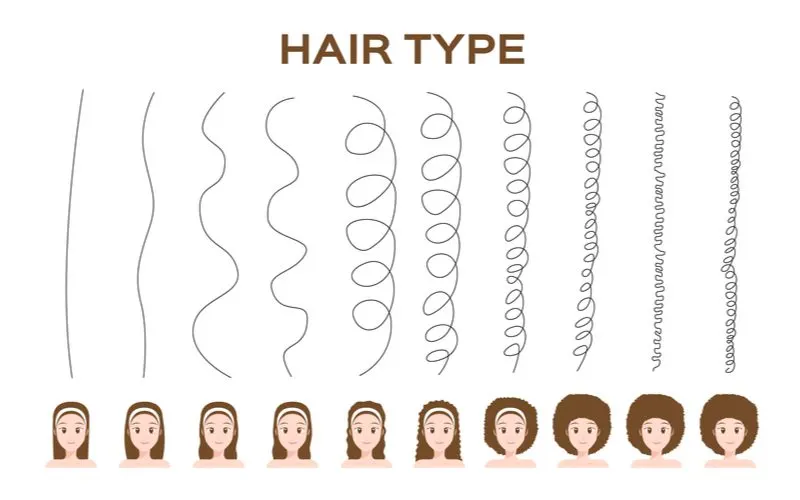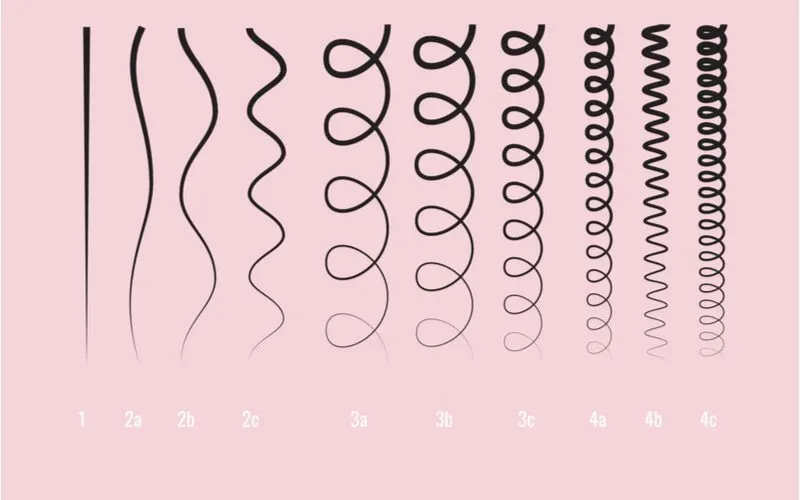Jump to:
Being often confused for hair texture, many people don’t understand what textured hair is. If this describes you, don’t worry — you’re in the right place. We’ll show you what it is, why it matters, and much more.
What Exactly Is Textured Hair?

Red Confidential/Shutterstock
Textured hair is an umbrella term for different types and textures of hair. The first thing to know is that straight hair is not considered textured hair. Of course, while every hair has a different texture or “feel” to it, textured hair has a specific meaning.
Textured hair is any hair that has strands with a particular shape. This shape is also called a curl pattern. The unique pattern of textured hair is especially noticeable in kinky, coily, or curly hair.
Many people use textured hair interchangeably with the phrase “natural hair,” often referring to the natural hair of persons with an African heritage.
Although this hair type is a type of textured hair, it isn’t the only type. To identify as someone with textured hair, your natural hair strands need to have a curl pattern.
What’s a Curl Pattern?
Now that you have an idea of what textured hair is, you’re probably wondering what curl pattern means. There are many different curl patterns, and if you have textured hair, your curl pattern is unique to you. Of course, these patterns generally fall into broad categories.
Your curl pattern determines how your hair looks after you wash it. It’s the state of your hair once it’s free from oil, dirt, and other products. Since your hair is free from products and different types of dirt, your natural hair can show.
Read Next: Best Products for Curly Hair
Types of Textured Hair

Gritsalak Karalak/Shutterstock
Knowing the type of textured hair you have allows you to understand your curl pattern better. These types are Type 2 (wavy), Type 3 (curly), and Type 4 (coily).
The three types are further divided into three sub-types. These subtypes are labeled A, B, and C, with A being the loosest curls and C being the tightest. Here is a breakdown of all the curl patterns and their subtypes:
1. Type 2 (Wavy Hair)
Type 2 hair is the straightest textured hair in the textured hair family. It’s divided into three subtypes, with A being the loosest and C having the tightest curls. Here’s all you need to know about the three types of wavy hair:
Type 2A
If your hair has a fine texture and a slight curl, you’re probably one of the members of the textured hair with Type 2A hair. Type 2A is the closest textured hair type to straight. Its slight curls and sleek strands characterize it. If you have 2A hair, you don’t even have to do much work to style it.
Type 2A hair has a naturally gentle and tousled feel. Your hair is straight from around your roots to eye level; then, it is a loose wave from eye level to your hair’s ends.
Type 2B
If your hair strands are straight from the roots of your hair and become wavy around the middle of your hair, you’re dealing with Type 2B hair. Type 2B hair curls from the middle of your hair’s length to the end, giving an S-shape that has slightly more definition than Type 2A’s curls.
Type 2C
If you have more defined waves or even ringlets, you probably have Type 2C hair. Type 2C hair has a slightly more coarse texture than the previous types in its family.
Type 2C has the best-defined curls in the Type 2 bunch. The curls usually start close to the crown, then go downwards. Type 2C hair is thick and can be frizzy when the weather is damp.
Read Next: How to Get Rid of Frizzy Hair
2. Type 3 (Curly Hair)
Type 3 hair has more well-defined curls than type 2, and these curls even border on springy. Here’s a breakdown from type 3A to type 3C:
Type 3A
Type 3A is distinct with its well-defined, ample, and bouncy curls. Type 3A hair has its S-shaped curls in quite loose loops. Type 3A curls are a little wider in circumference than a taper candle’s larger end. Make sure you don’t overbrush this hair type because it can make it frizzy.
Type 3B
If you have type 3B hair, it’s more springy than ordinarily curly hair. 3B hair is a level higher than 3A hair in terms of springiness. Its strands are slightly smaller in width than 3A, which makes your hair look fuller.
The curls are roughly the size of a Sharpie’s barrel. The curls start from the roots and are quite voluminous. If you have type 3B hair, you should keep it moisturized.
Type 3C
If your curls look like tight corkscrews or springs, you probably have type 3C hair. Type 3C hair has the thickest strands and tightest curls of the Type 3 bunch. Type 3C hair also has a lot of volume and bounce because of the springiness of its curls. The curls are tight enough that they can fit around a straw perfectly.
3. Type 4 (Coily Hair)
Type 4 has more of a coily than curly texture—the hair curls into the tightest S-shape, being tighter than types 2 and 3.
Type 4A
Type 4A hair has the most visible curl patterns in the Type 4 family. It has small, tight, zigzag curls that can wrap around a chopstick. Type 4A coils zigzag from the roots of the hair down to the ends of the hair.
Type 4B
Type 4B coils have a different shape from other textured hair. Instead of the usual S-shape, 4B hair has Z-shaped coils. Type 4B hair zigzags instead of curls, making taking care of it a little more complex.
Type 4C
Last but not least in the textured hair family is Type 4C hair! Type 4C hair is the most coily and most delicate of all textured hair. This hair type has a wide range of textured, from thin to coarse. Their super coily zigzags make them prone to breakage, less definition, and shrinkage than other hair types.
Read Next: How to Texturize Hair
Frequently Asked Questions

Cuppuccino/Shutterstock
Here are some frequently asked questions about textured hair:
How Do I Keep My Hair Healthy?
Persons with textured hair must take expert care to protect their hair from breakage and dryness. Here are some ways to protect your hair:
- Don’t add too many products to your hair
- Drink a lot of water
- Air-dry your hair as often as you can
- Keep your hair follicles clean
How Do I Know My Curl Pattern?
To know your natural curl pattern, you need to wash your hair. To better understand your curl pattern, make sure your hair isn’t being modified by styling equipment or products. Let your hair air dry without any product after you rinse it.
As soon as your hair is dry, examine your curl pattern and try to spot the features mentioned above. Although you can have multiple curl patterns, there will most likely be one dominating pattern.
You should also note that coloring or heat styling your hair can impact your hair’s curl pattern. Because heat-damaged strands may not return to their natural curl type, if you’ve been wearing your hair straight for a time, your new growth will reveal a more natural texture.
You can also use hair treatments to rejuvenate your curl pattern and bring it back to life. Simply examine the shape of your strands in the mirror once your hair is clean and dry.
You know you have Type 2 hair if your strands have a wavy texture. Do you have springy curls? Then you’re a member of the Type 3 group. Do you have zig-zag strands with tight little curls? Your hair is Type 4!
So, What Is Textured Hair?
As you now know, textured hair is any hair type that has a specific and unique curl pattern. It is sometimes complex to deal with textured hair, but it can provide some very unique hairstyles. Embrace your curly mane now and rock it!
